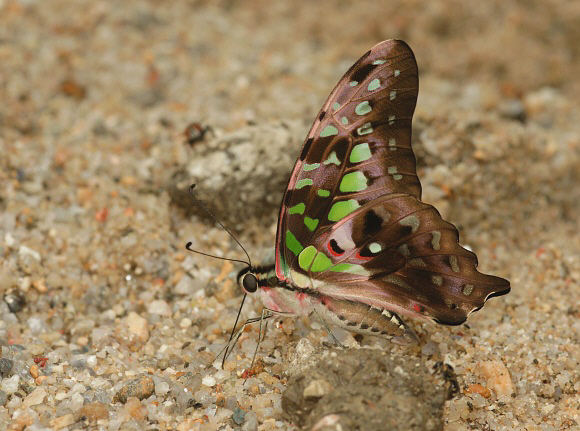Introduction
The genus Graphium is widespread in the Old World, with 35 species in the Afrotropical region, 14 in the Oriental region, 6 in the Holarctic ( south & west China ) and 20 in the Australian region.
Most of the Oriental and Australasian species are characterised by the presence of a pattern of translucent green, turquoise or yellowish “windows” in their wings. There are a few however such as aristeus from New Guinea and the Oriental species euphrates which are predominantly white, marked with vertical black stripes. Arguably the most beautiful and unusual of all is weiskei from Papua, a tailed species patterned with vivid pink and green on a dark brown ground colour.
Several Graphium species such as the African policenes have very long sword-like tails. Some of the Oriental species e.g. codrus, cloanthus and certain races of agamemnon have short tails, but in others including sarpedon, doson and eurypylus the tails are greatly reduced or absent.
Graphium agamemnon is one of the most widespread species in the genus, being found from India and Sri Lanka to Hong Kong, and through the archipelago to Papua New Guinea, Queensland and the Solomon Islands.

Habitats
This species is found in open habitats including forest clearings, riverbanks and beach hinterlands, at elevations between sea level and about 500m.
Lifecycle
The smooth, spherical, pale green eggs are laid singly on the upperside of young leaves of sapling trees in the family Annonaceae. Species used include Ancana, Annona, Cyathostemma, Desmos, Fitzalania, Friesodeilsia, Goniothalamus, Haplostichanthus, Melodorum, Mitrephora, Oncodostigma, Pseuduvaria, Rauwenhoffia, Rollinia, Saccopetalum, Uvaria and Xylopia. Larvae have also been found on Michelia ( Magnoliaceae ) and Cinnamomum ( Lauraceae ).
When young the caterpillar is ochreous-brown, with a white saddle on the rear segments. The anal segment and each of the thoracic segments is adorned with a pair of short multi-branches spines. Throughout its life the caterpillar habitually rests on the upperside of a leaf, along the midrib, and feeds by nibbling large chunks from the tip of the leaf, but leaving the midrib intact.
The mature caterpillar is plump, mid green in colour, with small suffused blotches of darker green. The spines by this stage are much reduced, becoming nothing more than a set of tiny black spikes.
The chrysalis is pale green or light brown, with a brown-tipped thoracic horn. It is attached by the cremaster and a silken girdle to the underside of a leaf.
Adult behaviour
Graphium species are generally more robust than their relatives in Papilio, and have a stronger and more purposeful flight.
They commonly nectar at flowering bushes, particularly favouring Lantana. Prior to mating they can often be seen circling around the tops of flowering trees, where courtship takes place. After mating, males visit damp sand and gravel to obtain essential minerals to replace those lost during sperm transfer. G. agamemnon however does not visit sandbanks or river beaches in such numbers as its relative sarpedon – a typical aggregation might for example consist of 50 sarpedon, 20 doson and just 1 or 2 agamemnon.
In common with the other aforementioned Graphium species, agamemnon males adopt the ‘filter-feeding’ technique – using their proboscises to continually suck up water from which they extract sodium and other minerals. They constantly pump the water through their bodies, expelling the surplus from the anus, using it to dissolve further minerals from the ground, which they re-imbibe.
Late on sunny afternoons, when temperatures drop, males often bask on bushes, with their wings fully outspread. A short while later they go to roost, usually at the top of a sapling tree.
